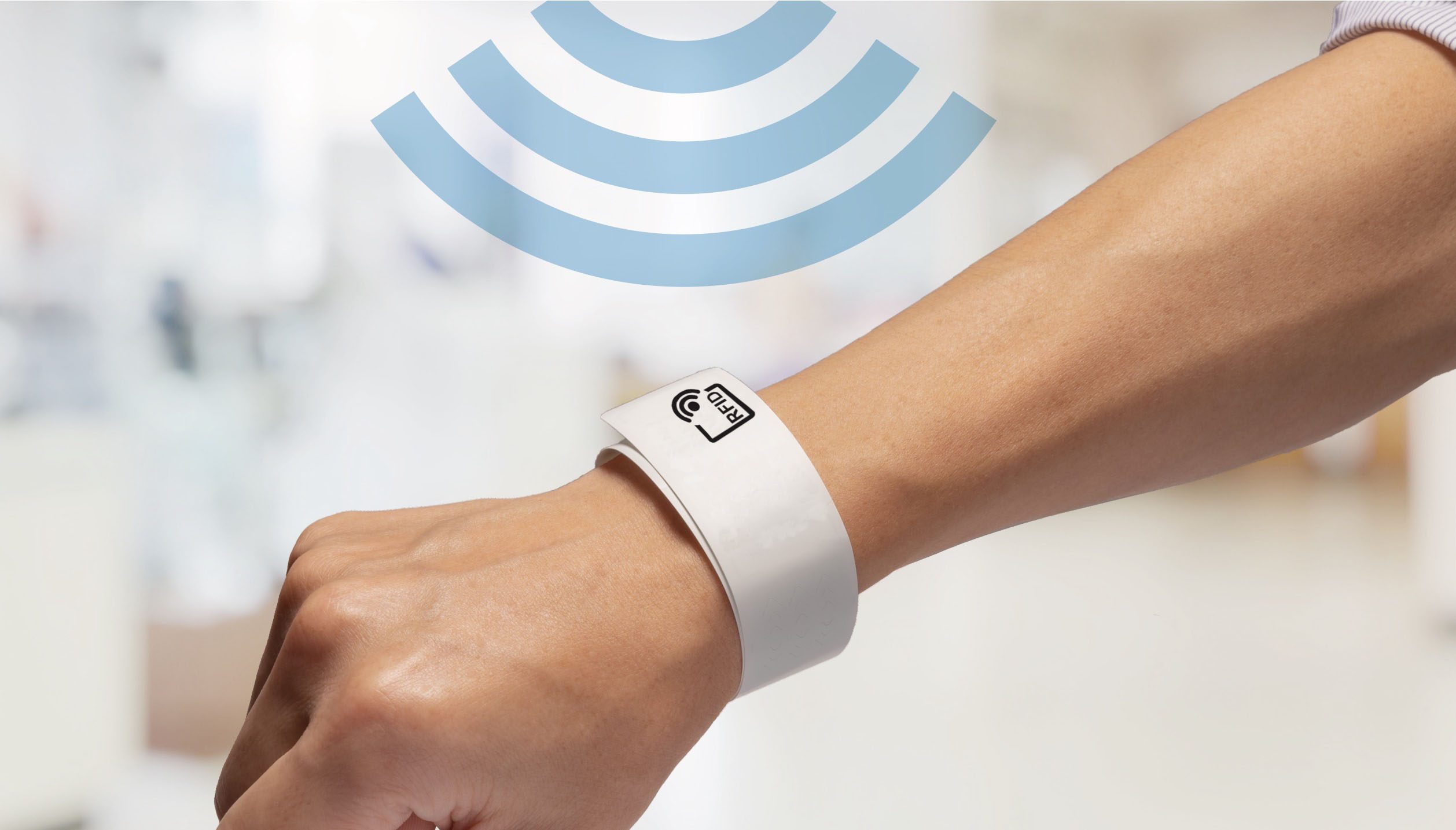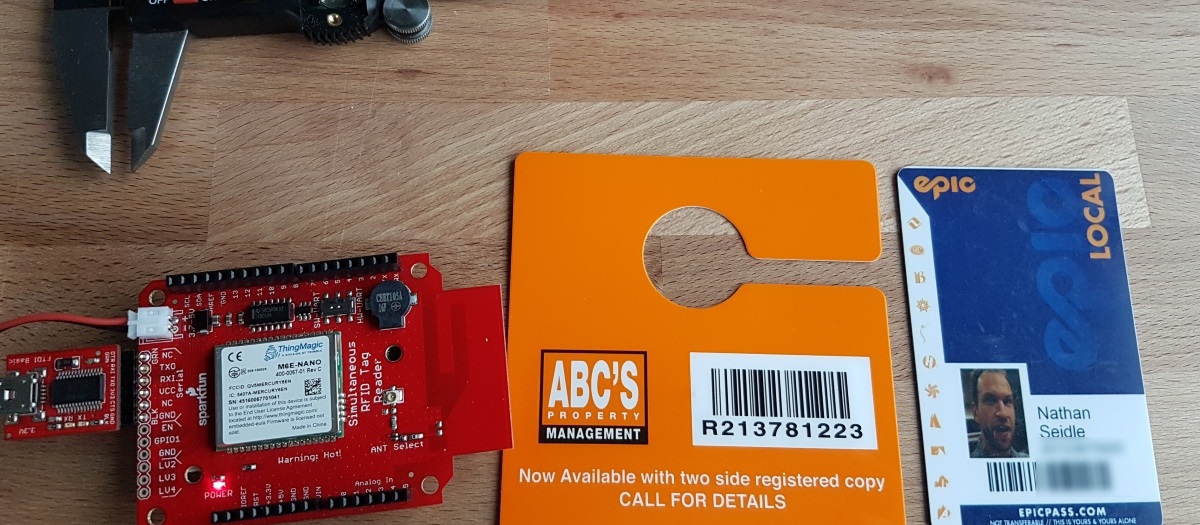Introduction
RFID, which stands for Radio Frequency Identification, is a cutting-edge technology that has revolutionized the way businesses track and manage inventory, assets, and personnel. It offers a more efficient and accurate alternative to traditional barcode systems, allowing for seamless data collection and real-time visibility.
At its core, RFID utilizes radio frequency signals to transmit data between a reader and a tag. Unlike barcodes that require line-of-sight scanning, RFID tags can be read from a distance and even through materials, making it ideal for various applications across industries.
This technology has gained significant popularity due to its widespread adoption in supply chain management, retail, healthcare, logistics, and asset tracking. It offers numerous advantages such as improved inventory management, enhanced security, increased operational efficiency, and reduced costs.
In this article, we will delve into the world of RFID, exploring its definition, how it works, the components of an RFID system, types of RFID tags, applications of RFID technology, as well as its advantages and disadvantages.
By understanding the basics of RFID and its potential applications, businesses can make informed decisions about integrating this technology into their operations, leading to optimized workflows and improved overall performance.
Definition of RFID
Radio Frequency Identification (RFID) is a technology that enables the wireless transmission of data between a reader and a tag using radio frequency signals. The RFID system consists of three main components: the reader, the tag, and the backend software.
The reader, also known as an RFID scanner or interrogator, emits radio waves and receives signals from the RFID tags within its range. These readers can be handheld devices, fixed installations, or integrated into larger systems.
RFID tags, also called transponders, are small devices that contain an antenna and a microchip. The antenna receives the radio waves from the reader and powers the microchip, allowing it to transmit and store data. There are two types of RFID tags: active tags, which have their own power source, and passive tags, which rely on the energy received from the reader for power.
The backend software is responsible for processing the data collected by the RFID system. It manages the communication between the reader and the tag, captures and analyzes the collected data, and integrates it into existing systems for analysis and decision-making.
RFID technology can be used for various purposes, including inventory management, asset tracking, access control, identification, and authentication. It offers a more efficient and automated approach compared to traditional manual methods, such as barcode scanning.
Unlike barcodes, which can only store limited information, RFID tags can store and transmit large amounts of data. This allows for unique identification of each item or asset, enabling businesses to track and manage their inventory more accurately and effectively.
In summary, RFID is a wireless technology that utilizes radio frequency signals to transmit data between a reader and a tag. This technology has proven to be highly beneficial for businesses across industries, offering improved tracking, inventory management, and operational efficiency.
How RFID Works
RFID technology operates based on the principles of electromagnetic fields and radio waves. The process involves three main steps: interrogation, transponder response, and data capture.
1. Interrogation: The RFID reader emits a radio wave signal through its antenna, which creates an electromagnetic field. When an RFID tag enters the range of this field, it is energized by the electromagnetic energy.
2. Transponder response: The energized RFID tag detects the radio wave signal and uses the energy received to power its microchip. The microchip then modulates the energy to transmit a unique identifier or other relevant information back to the reader.
3. Data capture: The RFID reader receives the transmitted data from the tag and demodulates it, converting it into a digital format that can be processed and analyzed. The reader then sends this data to the backend software for further processing or integration into existing systems.
The communication between the reader and tag can be either passive or active. In passive RFID systems, the reader supplies the energy needed to power the tag through the electromagnetic field. This makes passive tags smaller, more cost-effective, and suitable for applications such as inventory management or access control.
On the other hand, active RFID systems utilize tags with their own power source, such as a battery. These tags can transmit data over longer distances and offer more advanced features, making them ideal for tracking high-value assets or locating objects in real-time.
RFID technology can operate over different frequency bands, including low frequency (LF), high frequency (HF), and ultra-high frequency (UHF). LF systems are typically used for short-range applications, such as access control or animal tracking. HF systems are commonly employed in contactless payment systems or electronic passports. UHF systems, with their longer read ranges and higher data transfer rates, are prevalent in logistics, supply chain management, and retail environments.
Overall, RFID technology provides a seamless and efficient way to capture and transmit data wirelessly between a reader and a tag. This enables businesses to automate processes, enhance tracking capabilities, and gain valuable insights for improved decision-making.
Components of an RFID System
An RFID system consists of several key components that work together to enable the successful implementation and operation of RFID technology. These components include the reader, the tag, and the backend software.
1. Reader: The RFID reader, also known as an interrogator, is the device responsible for generating and sending radio frequency signals to interact with the RFID tags. It contains an antenna for transmitting and receiving radio waves to communicate with the tags. Readers can be either handheld devices or fixed installations, depending on the specific application requirements.
2. Tag: The RFID tag, also called a transponder, is an electronic device that stores and transmits data wirelessly. It consists of an antenna and a microchip, which contains the information to be transmitted to the reader. Tags can be either passive or active. Passive tags rely on the energy received from the reader’s signal to power the microchip, while active tags have their own power source, typically a battery.
3. Backend Software: The backend software acts as the bridge between the RFID readers and the enterprise systems. It manages the communication between the readers and the tags, captures and analyzes the data collected from the tags, and integrates this data into existing systems for further processing and utilization. The software can also provide features such as data filtering, real-time monitoring, and reporting.
4. Communication Infrastructure: In addition to the reader, tag, and software components, an RFID system requires a reliable communication infrastructure to facilitate the transmission of data. This infrastructure may include wired or wireless network connections, antennas, and other hardware devices that enable seamless communication between the various components of the system.
5. Integration with Existing Systems: One crucial aspect of an RFID system is its ability to integrate with existing enterprise systems, such as inventory management systems, asset tracking systems, or customer relationship management (CRM) systems. This integration allows for the seamless flow of data and enables organizations to leverage the benefits of RFID technology within their existing workflows.
6. Data Storage and Analytics: The data collected from RFID tags can be stored and analyzed for actionable insights. Organizations can use data storage systems and analytics tools to analyze the collected data, identify patterns, track inventory levels, monitor asset movement, and make informed decisions based on real-time information.
By understanding the key components of an RFID system, businesses can design and implement a comprehensive solution that meets their specific needs. Whether it’s improving inventory management, enhancing supply chain visibility, or streamlining asset tracking, the components of an RFID system work together to enable efficient and effective operations.
Types of RFID Tags
RFID tags come in various forms and configurations, each designed to cater to different applications and environments. There are primarily two types of RFID tags: active tags and passive tags.
1. Passive RFID Tags: Passive tags are the most commonly used RFID tags due to their cost-effectiveness and simplicity. These tags do not have their own power source and rely on the energy emitted by the RFID reader for operation. When the reader’s radio frequency signal energizes the tag, it reflects or scatters back a response containing the tag’s unique identifier or other stored data. Passive tags have a limited read range, typically up to a few meters, but they are suitable for applications such as inventory management, supply chain tracking, and access control.
2. Active RFID Tags: Active tags, unlike passive tags, have their own power source, usually a battery within the tag. This power source allows active tags to transmit their own signal, making them capable of longer read ranges, even exceeding 100 meters. Active tags are often used for applications that require real-time tracking, such as tracking high-value assets, monitoring vehicle movement in toll collection systems, or managing personnel in secure environments. However, active tags are more expensive than passive tags and have a limited battery life that needs to be periodically replaced or recharged.
There are also variations within these broad categories of passive and active tags:
– Low-Frequency (LF) Tags: LF tags operate in the frequency range of 125 kHz to 134 kHz and are commonly used for applications such as animal tracking, access control, and keyless entry systems.
– High-Frequency (HF) Tags: HF tags operate in the frequency range of 13.56 MHz and find applications in contactless payment systems, electronic passports, and NFC (Near Field Communication) applications.
– Ultra-High Frequency (UHF) Tags: UHF tags operate in the frequency range of 860 MHz to 960 MHz and are widely used in retail inventory management, supply chain logistics, and asset tracking due to their longer read range and higher accuracy.
– Micro Passive Tags: Micro passive tags are tiny in size, with dimensions comparable to a grain of rice. These tags are used for applications where size and discreetness are vital, such as in medical facilities for tracking surgical instruments or in the jewelry industry for tracking valuable items.
The choice of RFID tag depends on factors such as the read range required, the environment in which the tags will be deployed, the desired level of functionality, and the budget allocated for the RFID solution. Understanding the different types of RFID tags enables organizations to select the most suitable tag for their specific application needs.
Applications of RFID Technology
RFID technology has found widespread applications across various industries, providing businesses with improved efficiency, accuracy, and visibility in their operations. Some of the key applications of RFID technology include:
1. Supply Chain Management: RFID enables real-time visibility and tracking of inventory throughout the supply chain, from manufacturing to distribution to retail. It enhances inventory accuracy, reduces out-of-stock situations, minimizes stockouts, improves order fulfillment, and optimizes logistics operations.
2. Retail and Inventory Management: RFID tags can be attached to individual products, allowing retailers to track inventory levels more efficiently. This technology enables retailers to perform inventory counts rapidly, automate stock replenishment, prevent theft, and improve overall store operations.
3. Asset Tracking: RFID technology enables organizations to track and manage their assets more effectively. Whether it’s equipment in healthcare facilities, tools in manufacturing plants, or vehicles in logistics operations, RFID tags provide real-time information about asset location, condition monitoring, maintenance schedules, and overall asset utilization.
4. Access Control and Security: RFID tags are commonly used in access control systems for secure entry to buildings, parking garages, or restricted areas within organizations. By using RFID-enabled access cards or key fobs, organizations can enhance security and restrict unauthorized access.
5. Livestock and Animal Tracking: RFID tags are used to track and monitor livestock or animal movement in agriculture and farming. This technology aids in identification, traceability, disease control, and overall livestock management.
6. Healthcare and Medical Applications: RFID technology plays an essential role in the healthcare industry by improving patient safety, inventory management, and asset tracking. RFID-enabled wristbands can be used to identify patients and ensure accurate medication administration. RFID tags on medical equipment and supplies help track usage, expiration dates, and improve inventory levels.
7. Waste Management: RFID tags are used in waste management systems to monitor and track waste bins and containers. This allows for efficient waste collection, optimized routing, and improved overall waste management processes.
8. Document Tracking: RFID tags can be attached to sensitive documents or files, enabling organizations to track their movement, secure access, and prevent loss or unauthorized tampering.
9. Transportation and Logistics: RFID technology improves visibility and efficiency in transportation and logistics operations. It enables automated tracking of packages or parcels, streamlines inventory management in warehouses, and enhances supply chain traceability.
These are just a few examples of the extensive range of applications for RFID technology. As the technology continues to evolve and become more affordable, we can expect to see further integration into various industries, providing businesses with real-time insights and operational benefits.
Advantages of RFID
RFID technology offers numerous advantages over traditional methods of data collection and tracking, making it an attractive choice for businesses across industries. Some of the key advantages of RFID include:
1. Increased Efficiency: RFID technology enables fast and automated data capture, eliminating the need for manual scanning and recording. This saves time, reduces human error, and increases overall operational efficiency.
2. Real-Time Tracking: RFID tags provide real-time visibility into the location and movement of assets, inventory, or personnel. This allows for better decision-making, improved asset utilization, and enhanced supply chain management.
3. Improved Accuracy: Unlike barcode systems, which are prone to errors due to line-of-sight scanning, RFID technology can accurately read multiple tags simultaneously, even through packaging or in challenging environments. This leads to higher accuracy in inventory management, asset tracking, and order fulfillment.
4. Seamless Integration: RFID systems can easily integrate with existing enterprise systems, such as inventory management, warehouse management, or customer relationship management (CRM). This allows for the smooth flow of data, making it easier to track and manage assets, inventory, and customer information.
5. Enhanced Security: RFID tags can be encoded with unique identifiers or authentication credentials, ensuring secure access to restricted areas or sensitive information. This technology helps prevent unauthorized access, reduces theft, and enhances overall security measures.
6. Cost Savings: While the initial investment in RFID technology may seem substantial, it often pays off in the long run. RFID systems reduce labor costs associated with manual data collection and inventory counts. They also minimize losses due to inaccurate inventory management, shrinkage, or misplaced assets.
7. Better Customer Experience: RFID technology enables retailers to provide a better customer experience by reducing checkout times, ensuring accurate inventory availability, and offering personalized services based on customer preferences and purchase history. This improves customer satisfaction and loyalty.
8. Scalability: RFID systems can easily scale with business growth and evolving needs. Additional tags and readers can be added without significant disruption, allowing for seamless expansion of operations.
9. Environmental Benefits: RFID technology eliminates the need for paper-based systems, excessive manual data entry, and barcode labels. This helps reduce paper waste, improve sustainability efforts, and contribute to a greener environment.
10. Data Analytics: The data collected from RFID systems can be analyzed to gain valuable insights into operational patterns, consumer behavior, inventory levels, and supply chain performance. This data-driven analysis facilitates better decision-making and strategic planning.
In summary, RFID technology offers numerous advantages such as increased efficiency, real-time tracking, improved accuracy, seamless integration, enhanced security, cost savings, better customer experience, scalability, environmental benefits, and data analytics. These advantages make RFID an indispensable tool for businesses striving to optimize their operations and stay competitive in today’s fast-paced business landscape.
Disadvantages of RFID
While RFID technology offers significant benefits, it is important to consider some of the potential disadvantages that organizations may encounter when implementing RFID systems. These include:
1. Cost: The initial investment required for RFID infrastructure, including tags, readers, and software, can be relatively high compared to traditional barcode systems. This cost can be a barrier for small businesses or organizations with limited budgets.
2. Privacy Concerns: RFID tags can store and transmit unique identifying information, raising privacy concerns. If not properly secured, unauthorized individuals or entities could potentially intercept or clone the information from the tags, compromising personal or sensitive data.
3. Read Range Limitations: The read range of RFID tags is influenced by factors such as the type of tag, frequency used, and the presence of obstacles. In certain environments, such as densely packed shelves or crowded areas, the read range may be limited, requiring careful placement of readers and tags for effective data capture.
4. Interference: RFID systems operate using radio frequency signals, which can be subject to interference from other electronic devices or materials. This interference can affect the reliability and accuracy of data transmission, leading to errors or incomplete readings.
5. Standardization: There are multiple RFID standards and protocols in use, which can lead to compatibility issues and hinder interoperability between different RFID systems or vendors. Ensuring compatibility and seamless integration between systems from different manufacturers can be challenging.
6. Environmental Factors: Certain environmental conditions, such as extreme temperatures or exposure to water or chemicals, can affect the performance and durability of RFID tags. Specialized tags may be required for harsh or demanding environments, increasing the overall cost of implementation.
7. Tag Collision: In scenarios where multiple RFID tags are present within the range of a reader simultaneously, tag collision can occur. This can lead to difficulties in identifying and capturing data from specific tags, requiring additional measures such as anti-collision algorithms to manage the issue effectively.
8. Data Management: The data collected from RFID systems can be vast and complex. Organizations need robust data management systems and processes to handle and utilize this data effectively. Without proper management, the influx of data can be overwhelming and hinder the ability to derive actionable insights.
9. Regulation and Compliance: Depending on the industry and application, RFID systems may need to comply with specific regulations and standards related to data privacy, security, or electromagnetic interference. Ensuring compliance with these regulations can add complexity and costs to the implementation process.
While these disadvantages should be taken into consideration, advancements in technology, industry standards, and best practices continue to address many of these challenges. By carefully planning and implementing RFID systems, organizations can mitigate potential drawbacks and fully leverage the benefits that RFID technology offers.
Conclusion
RFID technology has proven to be a game-changer for businesses across industries, offering improved efficiency, accuracy, and visibility in various applications. From supply chain management to retail inventory control, asset tracking to access control, RFID systems have revolutionized the way organizations track and manage their operations.
The advantages of RFID technology are clear. It provides real-time visibility, enhances operational efficiency, streamlines inventory management, improves security measures, and enables seamless integration with existing systems. With the ability to capture and transmit data wirelessly, RFID technology offers a more efficient and automated alternative to traditional manual methods of data collection.
However, organizations must also consider the potential disadvantages of RFID technology. The cost of implementation, privacy concerns, read range limitations, and compatibility issues are some challenges that need to be addressed during the planning and implementation stages. Ensuring data security, compliance with regulations, and effective data management processes are also crucial for successful RFID system deployment.
As technology continues to evolve, RFID systems are becoming more advanced, cost-effective, and versatile. Industry standards and best practices are constantly improving, addressing many of the earlier challenges. With proper planning, implementation, and ongoing management, organizations can overcome these disadvantages and fully leverage the benefits that RFID technology has to offer.
Ultimately, RFID technology presents immense opportunities for businesses to optimize their operations, improve customer experiences, and gain a competitive edge in the market. As industries continue to embrace digital transformation, RFID technology will play a vital role in shaping the future of inventory management, asset tracking, supply chain optimization, and beyond.

























